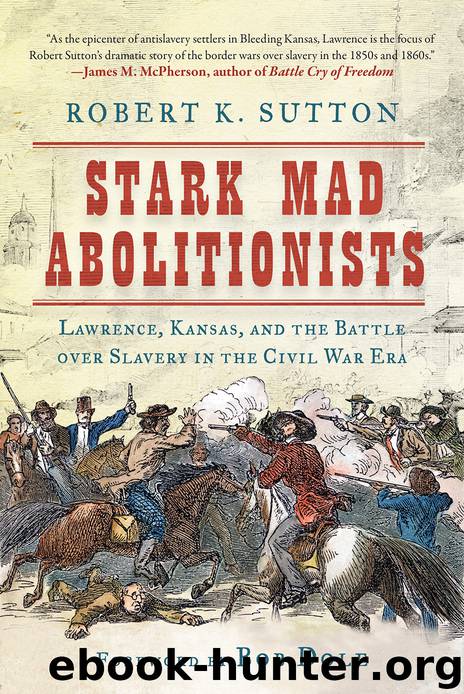Stark Mad Abolitionists by Robert K. Sutton

Author:Robert K. Sutton
Language: eng
Format: epub
Publisher: Skyhorse Publishing
Published: 2017-07-07T04:00:00+00:00
Lithograph of Battle of Wilson’s Creek. Library of Congress.
Eight days after the battle, Edward R. Nash, the adjutant for the 1st Kansas, wrote a letter to Hattie Jones. It began as did many letters, written by many soldiers after many battles. Nash wrote: “it becomes my painful duty to inform you of the death of your husband, and my friend. He was killed in the battle of Wilson’s Creek on the 10th instant.” He continued: “he [Lieutenant Jones] suddenly said to Joe Gilliford, who was at his side, ‘Joe I am shot.’ Joe asked ‘where?’ Jones’s answer was ‘in my hip.’ Just at that moment a ball came whizzing by Joe’s ear—he turned his head quickly and saw Jones fall, shot again in the left breast in the region of the heart by a Minnie [sic] ball.” Nash continued, saying that on the long journey from Kansas to Wilson’s Creek, Lieutenant Jones, on numerous occasions, predicted his own death, but Jones asked Nash: “if I go under and you come out safe, I want you to write to Hattie and tell her my last thought was for her.”219
Lieutenant Jones was one of seventy-seven members of the 1st Kansas killed in the battle. Another 255 were wounded. Six hundred and forty-four men and officers went into battle with the 1st Kansas, and 332, or over half of the regiment, were casualties.220 The 1st Kansas was one of the lead regiments in the attack and caught the brunt of the Confederate counterattack. The 2nd Kansas was held in reserve, with the exception of Captain Wood’s Company I, which was mounted infantry. In the heat of battle, the Second was called to the front, and according to an eyewitness, “stood firm, and met the enemy, handled him so roughly that he soon fell back in confusion.” For the 2nd Kansas, the best estimates are that five were killed, fifty-nine were wounded, and six were missing, for a total of seventy casualties.221
Reports from the battle reached Lawrence two weeks later, and the Lawrence Republican published an article, “The Martyrs of Freedom,” listing the casualties of the 1st Kansas. It drew particular attention to Lieutenant Jones’s death, saying he “was a man of brilliant intellect and a good heart.” The article also noted that Caleb B. Pratt, the city clerk, was killed, as was Lewis T. Litchfield, who left behind a wife and child. The article concluded by saying, “their names will be long remembered as heroes whose every pulsation was for the freedom and honor of their country.”222
Levant Jones, Caleb Pratt, and Lewis Litchfield were all part of the regular Kansas militia. They readily volunteered to fight as part of the Union Army, with the primary purpose of reuniting the country. There was another Kansas military contingent that, in addition to bringing the nation back together, was equally passionate that the institution of slavery needed to be annihilated wherever it existed. Their name has become synonymous with Kansas over the years—the Jayhawkers.
Download
This site does not store any files on its server. We only index and link to content provided by other sites. Please contact the content providers to delete copyright contents if any and email us, we'll remove relevant links or contents immediately.
| Africa | Americas |
| Arctic & Antarctica | Asia |
| Australia & Oceania | Europe |
| Middle East | Russia |
| United States | World |
| Ancient Civilizations | Military |
| Historical Study & Educational Resources |
Cat's cradle by Kurt Vonnegut(15128)
Pimp by Iceberg Slim(14272)
4 3 2 1: A Novel by Paul Auster(12245)
Underground: A Human History of the Worlds Beneath Our Feet by Will Hunt(11992)
The Radium Girls by Kate Moore(11887)
Wiseguy by Nicholas Pileggi(5627)
Perfect Rhythm by Jae(5294)
American History Stories, Volume III (Yesterday's Classics) by Pratt Mara L(5234)
The Fire Next Time by James Baldwin(5217)
Paper Towns by Green John(5057)
Pale Blue Dot by Carl Sagan(4880)
A Higher Loyalty: Truth, Lies, and Leadership by James Comey(4813)
The Mayflower and the Pilgrims' New World by Nathaniel Philbrick(4393)
The Doomsday Machine by Daniel Ellsberg(4387)
Killers of the Flower Moon: The Osage Murders and the Birth of the FBI by David Grann(4363)
The Sympathizer by Viet Thanh Nguyen(4278)
Too Much and Not the Mood by Durga Chew-Bose(4247)
The Borden Murders by Sarah Miller(4211)
Sticky Fingers by Joe Hagan(4078)
